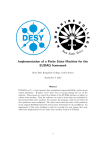Download EPC User's Guide
Transcript
EPC User’s Guide Editor: EURECOM Deliverable nature: Public Due date: July, 2015 Delivery date: June, 2015 Version: 0.2 Total number of pages: 32 Reviewed by: Keywords: EPC, LTE, MME, S-GW, HSS, S1AP, DIAMETER Abstract The deliverable presents the EPC developed by EURECOM. The document presents the deployment scenarios of the EPC, its configuration, installation and running. List of authors Company Authors EURECOM Christian BONNET, Lionel GAUTHIER, Rohit GUPTA, Florian KALTENBERGER, Raymond KNOPP, Navid NIKAIEN, Cedric ROUX. Laurent THOMAS. Page 2 of (32) © History Modified by Date Version Comments Lionel GAUTHIER 09/06/2015 0.1 Initial Draft Lionel GAUTHIER 11/06/2015 0.2 Minor corrections Page 3 of (32) © Table of Contents History .................................................................................................................................................... 3 Table of Contents .................................................................................................................................... 4 List of Figures ......................................................................................................................................... 6 List of tables............................................................................................................................................ 7 Abbreviations .......................................................................................................................................... 8 1 Introduction ..................................................................................................................................... 9 1.1 Overview ................................................................................................................................. 9 1.2 Deployment scenarios ............................................................................................................. 9 1.2.1 Separate EPC platform ........................................................................................................ 9 1.2.2 All in one EPC platform.................................................................................................... 10 2 EPC Installation ............................................................................................................................. 11 2.1 Operating system .................................................................................................................. 11 2.2 EPC source code ................................................................................................................... 11 2.3 Additional software, initial steps. ......................................................................................... 11 2.3.1 Mysql server installation details ....................................................................................... 12 2.3.2 Phpmyadmin installation details ....................................................................................... 12 3 EPC Configuration......................................................................................................................... 14 3.1 MME_GW ............................................................................................................................ 14 3.1.1 Fully Qualified Domain name ........................................................................................... 14 3.1.2 Configuration files ............................................................................................................ 14 3.2 MME ..................................................................................................................................... 15 3.3 SP_GW ................................................................................................................................. 15 3.4 MME configuration content .................................................................................................. 15 3.4.1 GUMMEI section.............................................................................................................. 15 3.4.2 SCTP section ..................................................................................................................... 16 3.4.3 S1AP section ..................................................................................................................... 16 3.4.4 S6A section ....................................................................................................................... 16 3.4.5 NAS section ...................................................................................................................... 16 3.4.6 INTERTASK_INTERFACE section ................................................................................ 16 3.4.7 Network interfaces section ................................................................................................ 16 3.5 S-GW configuration content ................................................................................................. 17 3.6 P-GW configuration content ................................................................................................. 18 3.6.1 Main section ...................................................................................................................... 18 3.6.2 Network interfaces section ................................................................................................ 18 3.6.3 IP Address Pool section .................................................................................................... 18 3.7 HSS ....................................................................................................................................... 19 3.7.1 Fully Qualified Domain name ........................................................................................... 19 3.7.2 Configuration files ............................................................................................................ 19 3.7.3 HSS database content ........................................................................................................ 22 4 Building and running ..................................................................................................................... 25 4.1 MME_GW. ........................................................................................................................... 25 4.1.1 Configuration files ............................................................................................................ 25 4.1.2 Building EPC .................................................................................................................... 25 4.1.3 Running EPC .................................................................................................................... 25 5 Supported scenarios in EPC........................................................................................................... 27 5.1 E-UTRAN Initial attach ........................................................................................................ 27 5.1.1 Attach with IMSI .............................................................................................................. 27 5.1.2 Attach with GUTI ............................................................................................................. 27 5.2 Tracking Area Update procedures ........................................................................................ 27 5.3 Routing Area Update procedures .......................................................................................... 27 5.4 Service Request procedures .................................................................................................. 27 5.4.1 UE triggered Service Request ........................................................................................... 27 5.4.2 Network triggered Service Request .................................................................................. 27 Page 4 of (32) © 5.5 S1 Release procedure ............................................................................................................ 27 5.6 GUTI Reallocation procedure ............................................................................................... 27 5.7 Detach procedure .................................................................................................................. 27 5.7.1 UE-Initiated Detach procedure for E-UTRAN ................................................................. 27 5.7.2 MME-Initiated Detach procedure for E-UTRAN ............................................................. 27 5.7.3 HSS-Initiated Detach procedure for E-UTRAN ............................................................... 27 5.8 HSS User Profile management function procedure .............................................................. 27 5.9 Bearer deactivation ............................................................................................................... 27 5.9.1 PDN GW initiated bearer deactivation ............................................................................. 27 5.9.2 MME initiated Dedicated Bearer Deactivation ................................................................. 27 5.10 Intra E-UTRAN handover..................................................................................................... 28 6 Annex A: Tools for observing, debugging. ................................................................................... 29 6.1 Itti_analyzer .......................................................................................................................... 29 6.1.1 Installation......................................................................................................................... 29 6.1.2 Execution .......................................................................................................................... 29 6.2 Wireshark/tshark ................................................................................................................... 30 6.3 Mscgen .................................................................................................................................. 30 6.4 S1AP scenario replay ............................................................................................................ 31 6.4.1 Capture a scenario ............................................................................................................. 31 6.4.2 build a S1AP scenario from pcap trace ............................................................................. 32 6.4.3 Replay a S1AP scenario .................................................................................................... 32 Page 5 of (32) © List of Figures Figure 1 EPC overview ........................................................................................................................... 9 Figure 2 EPC Deployment in MME SP-GW .......................................................................................... 9 Figure 3 EPC Deployment in MME_GW ............................................................................................. 10 Figure 4 Mysql installation root password............................................................................................ 12 Figure 5 Phpmyadmin installation conf DB ......................................................................................... 12 Figure 6 Phpmyadmin installation DB password ................................................................................. 13 Figure 7 Phpmyadmin installation app password ................................................................................. 13 Figure 8 Phpmyadmin installation web server selection....................................................................... 13 Figure 9 MME_GW configuration files generation .............................................................................. 14 Figure 10 HSS configuration files generation....................................................................................... 19 Figure 11 ITTI Analyzer main window ................................................................................................ 29 Figure 12 ITTI Analizer select filter menu ........................................................................................... 30 Figure 13 Mscgen output example ........................................................................................................ 31 Page 6 of (32) © List of tables Table 1 MME configuration main section ............................................................................................ 15 Table 2 MME configuration subsection GUMMEI .............................................................................. 15 Table 3 MME configuration subsection SCTP ..................................................................................... 16 Table 4 MME configuration subsection S1AP ..................................................................................... 16 Table 5 MME configuration subsection S6a......................................................................................... 16 Table 6 MME configuration subsection NAS....................................................................................... 16 Table 7 MME configuration subsection ITTI ....................................................................................... 16 Table 8 MME configuration subsection Network Interfaces ................................................................ 17 Table 9 S-GW configuration main section ........................................................................................... 17 Table 10 P-GW configuration main section ......................................................................................... 18 Table 11 P-GW configuration subsection Network Interfaces ............................................................. 18 Table 12 P-GW configuration subsection IP Address Pool Selection .................................................. 18 Table 13 SQL Table structure mmeidentity.......................................................................................... 22 Table 14 SQL Table structure pdn ........................................................................................................ 23 Table 15 SQL Table structure users...................................................................................................... 24 Page 7 of (32) © Abbreviations 3GPP Third Generation Partnership Project. APN Access Point Name. CIDR Classless Inter-Domain Routing. eNB e Node B. EPC Evolved Packet Core. EPS Evolved Packet System. FQDN Fully qualified domain name. HSS Home Subscriber Server. IMEI International Mobile Station Equipment Identity. IMEISV International Mobile Station Equipment Identity Software Version. LTE Long Term Evolution. MME Mobility Management Entity. MSISDN Mobile Station International Subscriber Directory Number. NW Network. P-GW PDN Gateway, Packet Data Network Gateway. PDN Packet Data Network. QoS Quality of Service. SCTP Stream Control Transmission Protocol. S-GW Serving Gateway. SIM Subscriber Identity Module. TCP Transmission Control Protocol. USIM Universal Subscriber Identity Module. Page 8 of (32) © 1 Introduction 1.1 Overview The EURECOM EPC is a bundle of software components that provides the MME, S+P-GW, HSS functions of the LTE core EPC architecture (http://www.3gpp.org/DynaReport/23002.htm). Actually the SGW and the PGW are merged together, there is no S5 or S8 interface between the two functional entities. Figure 1 EPC overview 1.2 Deployment scenarios Two deployment scenarios are considered with the EURECOM EPC. 1.2.1 Separate EPC platform Actually this deployment scenario is under development and cannot be demonstrated yet. Figure 2 EPC Deployment in MME SP-GW Page 9 of (32) © 1.2.2 All in one EPC platform The following picture depicts a EURECOM EPC providing MME and GW functions, and interact with the EURECOM HSS. In this deployment scenario, the S11 interface is virtual in the sense that S11 messages do not go through the network layer but through an inter-task interface message passing middleware (ITTI). Figure 3 EPC Deployment in MME_GW The EPC can be deployed on the same EURECOM eNB host or on its own host. The HSS can be deployed on the same EPC host, EURECOM eNB host or on its own host. Any combination of deployment with one, two or three host(s) is possible with the EURECOM eNB. If a third party eNB is used, then it is preferable to run the EPC and HSS on one or two other hosts, indifferently. Page 10 of (32) © 2 EPC Installation 2.1 Operating system The EPC software has only been tested on UBUNTU 14.04x64, and UBUNTU 14.10x64 LINUX distributions on Intel x86 64 bits platforms. If you want to try another LINUX distribution, it is mandatory to have a 64 bits LINUX distribution. 2.2 EPC source code The OpenAirInterface software can be obtained from our svn server. You will need an svn client to get the sources (on Ubuntu Linux the client can be install using the command "apt-get install subversion"). The openair4G repository is currently used for main developments. It can be accessed in read-only mode from the URL http://svn.eurecom.fr/openair4G. If you have full access to our SVN you should use the URL http://svn.eurecom.fr/openairsvn/openair4G. Depending on what is recommended on the openair mailing list ([email protected]), you should use the trunk or the latest release. If svn is not installed on your computer, execute in a shell the following command: user@host:~ sudo apt-get install subversion Then to retrieve the source code, if you have read-only access, execute in a shell the following command: user@host:~ svn co http://svn.eurecom.fr/openair4G/trunk or user@host:~ svn co http://svn.eurecom.fr/openair4G/releases/rel_x.y_dd.mm.yyyy If you have write access: user@host:~ svn co http://svn.eurecom.fr/openairsvn/openair4G --username mysvnlogin The source code in a release directory or in the trunk directory is organized as follow: - cmake_targets : Openair build system (latest) - common : Common code to all layers - openair1 : Physical layer source code - openair2 : Layer 2(MAC, RLC, RRC, PDCP) source code - openair3 : Middleware code (mainly unused). - openair-cn : Core network protocols source code. - targets : Specific code for executables (may contains unsupported old build system). Important! In this document OPENAIR_DIR is the path to the openair working directory (may be trunk or rel_x.y_dd.mm.yyyy). 2.3 Additional software, initial steps. Some software installations have to be done prior to build the EURECOM EPC and the EURECOM HSS. Page 11 of (32) © In OPENAIR_DIR/cmake_targets directory, execute the following command: user@host:~/openair4G/trunk/cmake_targets$ tools/build_epc –i This command will update the software source list of your Ubuntu installation. It will install miscellaneous software packages, mainly an openair version (patched) of freeDiameter, an openair version (patched) of asn1c, and particularly mysql-server and phpmyadmin software, which steps are described below. 2.3.1 Mysql server installation details Enter here the root password of your host. Figure 4 Mysql installation root password The mysql-server installation process ends here. 2.3.2 Phpmyadmin installation details You should prefer the easiest way Figure 5 Phpmyadmin installation conf DB Enter here the root password of your host: Page 12 of (32) © Figure 6 Phpmyadmin installation DB password Accordingly with the content of openair configuration files, please, enter here admin Figure 7 Phpmyadmin installation app password Choose the web server that has to be configured: Apache. Figure 8 Phpmyadmin installation web server selection Page 13 of (32) © 3 EPC Configuration 3.1 3.1.1 MME_GW Fully Qualified Domain name A FQDN has to be set for the MME_GW. An easy way to do that is to fill this FQDN in the /etc/hosts file. Example: yang@yang:$ cat /etc/hosts 127.0.0.1 localhost 127.0.1.1 yang.openair4G.eur ... yang 192.168.12.175 yin.openair4G.eur hss yin ... 3.1.2 Configuration files Here is view of the build process of MME_GW, we can see there when and how configuration files are generated. Inputs files and parameters are on the left part of the figure, the build process is in the center part and output configuration files are on the right of the figure. Figure 9 MME_GW configuration files generation Configuration file Epc.conf and epc.local.enb.conf: Page 14 of (32) © These configuration files, since MME_GW is an aggregation of a MME, a S-GW and a P-GW, aggregate three configuration sections: a MME, a S-GW, and a P-GW configuration section. This configuration files follow the libconfig file syntax (http://www.hyperrealm.com/libconfig). These sections are described below. Configuration file mme_fd.conf: This configuration file is the input file for configuring the diameter protocol instance of the MME_GW. 3.2 MME Empty section, will be updated when a standalone MME will be released. 3.3 SP_GW Empty section, , will be updated when a standalone S+P-GW will be released. 3.4 MME configuration content Parameter Type REALM String Diameter realm of the MME MAXENB Num/Integer Maximum number of eNB that can connect to MME. MAXUE Num/Integer For debug purpose, used to restrict the number of served UEs the MME can handle. RELATIVE_CAPACITY Num/Integer Even though this parameter is not used by the MME for controlling the MME load balancing within a pool (at least for now), the parameter has to be forwarded to the eNB during association procedure. Values going from 0 to 255, (Default value is 15) MME_STATISTIC_TIMER Num/Integer Displayed statistic (stdout) period. EMERGENCY_ATTACH_SUPPORTED String UNAUTHENTICATED_IMSI_SUPPORTED String IP_CAPABILITY String Choice between IPV4, IPV4V6, IPV4ORV6 Table 1 MME configuration main section 3.4.1 GUMMEI section Parameter Type MME_CODE Array of Num/Integer List of a maximum of 256 values can be provided. MME code range is [0..255] MME_GID Array of Num/Integer List of maximum 65536 values. MME group id range is [0..65535] TAI Array of TAI (PLMN:TAC) List of maximum 32 TAI. (TAI=MCC.MNC:TAC) Table 2 MME configuration subsection GUMMEI Page 15 of (32) © 3.4.2 SCTP section Parameter Type SCTP_INSTREAMS Num/Integer Num streams for UE association signaling, note that stream with id =0 is reserved for non-Ue associated signaling. At least two streams should be used by the MME. (Default value=64) SCTP_OUTSTREAMS Num/Integer Idem above Table 3 MME configuration subsection SCTP 3.4.3 S1AP section Parameter Type S1AP_OUTCOME_TIMER Num/Integer Once an outcome is sent from MME to eNB, the MME locally starts a timer to abort the procedure and release UE context if the expected answer to this outcome is not received at the expiry of this timer. This timer is expressed in seconds. (Default value = 5 seconds) Table 4 MME configuration subsection S1AP 3.4.4 S6A section Parameter Type S6A_CONF String S6A config file path HSS_HOSTNAME String HSS hostname Table 5 MME configuration subsection S6a 3.4.5 NAS section Parameter Type ORDERED_SUPPORTED_INTEGRITY_ALGORITHM_LIST Array of String Preference list in decreasing order of supported integrity algorithms, actually supported integrity algorithms are EIA0, EIA1, EIA2 ORDERED_SUPPORTED_CIPHERING_ALGORITHM_LIST Array of String Preference list in decreasing order of supported integrity algorithms, actually supported integrity algorithms are EEA0, EEA1, EEA2 Table 6 MME configuration subsection NAS 3.4.6 INTERTASK_INTERFACE section Parameter Type ITTI_QUEUE_SIZE Num/Integer Upper bound for the message queue size expressed in bytes (all messages exchanged by tasks have the same size). Restrict the number of messages in queues or detect a possible MME overload. Table 7 MME configuration subsection ITTI 3.4.7 Network interfaces section Parameter Type MME_INTERFACE_NAME_FOR_S1_MME String Page 16 of (32) Interface name for S1-MME (S1-C) © MME_IPV4_ADDRESS_FOR_S1_MME String, CIDR Binded address for S1-MME MME_INTERFACE_NAME_FOR_S11_MME String Interface name for S11, “none” if S11 unused MME_IPV4_ADDRESS_FOR_S11_MME String, CIDR Binded address for S11, (0.0.0.0/xx) if S11 unused Table 8 MME configuration subsection Network Interfaces 3.5 S-GW configuration content Parameter Type SGW_INTERFACE_NAME_FOR_S11 String Interface name for S11, “none” if S11 unused SGW_IPV4_ADDRESS_FOR_S11 String, CIDR notation Binded address for S11, (0.0.0.0/xx) if S11 unused SGW_INTERFACE_NAME_FOR_S1U_S12_S4_UP String Interface name for S1-U SGW_IPV4_ADDRESS_FOR_S1U_S12_S4_UP String, CIDR notation Binded address for S1-U SGW_IPV4_PORT_FOR_S1U_S12_S4_UP Num/Integer Port number for S1-U (IANA), Should be 2152 SGW_INTERFACE_NAME_FOR_S5_S8_UP String, Interface name for S5 or S8, “none” because unused SGW_IPV4_ADDRESS_FOR_S5_S8_UP String, CIDR notation Binded address for S5 or S8, (0.0.0.0/xx) because unused Table 9 S-GW configuration main section Page 17 of (32) © 3.6 3.6.1 P-GW configuration content Main section Parameter Type DEFAULT_DNS_1_IPV4_ADDRESS String, IPv4 dot decimal IPv4 address of primary default DNS that can be queried by UEs DEFAULT_DNS_2_IPV4_ADDRESS String, IPv4 dot decimal IPv4 address of secondary default DNS that can be queried by UEs Table 10 P-GW configuration main section 3.6.2 Network interfaces section Parameter Type PGW_INTERFACE_NAME_FOR_S5_S8 String Interface name for S5 or S8, “none” because unused PGW_IPV4_ADDRESS_FOR_S5_S8 String, CIDR notation Binded address for S5 or S8, (0.0.0.0/xx) because unused PGW_INTERFACE_NAME_FOR_SGI String Interface name for SGi PGW_IPV4_ADDRESS_FOR_SGI String, CIDR notation Used IPv4 address for SGi, useful if UE traffic is masqueraded. PGW_MASQUERADE_SGI String Should outgoing UE IPv4 traffic be masqueraded (source NAT), “yes” or “no”. Table 11 P-GW configuration subsection Network Interfaces 3.6.3 IP Address Pool section Parameter Type IPV4_LIST String, CIDR notation List of IPv4 netmasks that designate a list of available IPv4 addresses for UEs IPV6_LIST String, CIDR notation List of IPv6 netmasks that designate a list of available IPv6 addresses for UEs Table 12 P-GW configuration subsection IP Address Pool Selection Page 18 of (32) © 3.7 3.7.1 HSS Fully Qualified Domain name A FQDN has to be set for the HSS. An easy way to do that is to fill this FQDN in the /etc/hosts file. Example: yin@yin:$ cat /etc/hosts 127.0.0.1 localhost 127.0.1.1 yin.openair4G.eur ... 3.7.2 yin Configuration files Here is partial view of the build process of HSS, we can see there when and how configuration files are generated. Inputs files and parameters are on the left part of the figure, the build process is in the center part and output configuration files are on the right of the figure. Figure 10 HSS configuration files generation Configuration file hss.conf.in: This configuration file is the top configuration file containing all necessary parameters and links to other configuration files. This file do not need to be edited, all parameters passed to the build_hss executable and also its default parameters are substituted in the right place in this config file. hss.conf.in content: ## MySQL mandatory options MYSQL_server = "@MYSQL_server@"; MYSQL_user = "@MYSQL_user@"; MYSQL_pass = "@MYSQL_pass@"; MYSQL_db = "@MYSQL_db@"; ## HSS options OPERATOR_key = "@OPERATOR_key@"; Page 19 of (32) © RANDOM = "@RANDOM_boolean@"; ## Freediameter options FD_conf = "@FREEDIAMETER_PATH@/../etc/freeDiameter/hss_fd.conf"; The following is an example of the resulting config file hss.conf: ## MySQL mandatory options MYSQL_server = "127.0.0.1"; MYSQL_user = "hssadmin"; MYSQL_pass = "admin"; MYSQL_db = "oai_db"; ## HSS options OPERATOR_key = "11111111111111111111111111111111"; RANDOM = "FALSE"; ## Freediameter options FD_conf = "/usr/lib/../etc/freeDiameter/hss_fd.conf"; Configuration file hss_fd.conf.in: This configuration file is the input file for configuring the diameter protocol instance of the HSS. All parameters values between ‘@’ are filled by the cmake process. These parameters are set with the help of input parameters passed to the build_hss executable, and with the help of default values set in the cmake_targets/hss_build/CMakeLists.txt file. You can see here what are default values defined in cmake_targets/hss_build/CMakeLists.txt and set your own: set(MYSQL_server "127.0.0.1" CACHE STRING "Database server IP address") set(MYSQL_admin root CACHE STRING "Database admin login") set(MYSQL_admin_pass linux CACHE STRING "Database admin password") set(MYSQL_user hssadmin CACHE STRING "Database username login") set(MYSQL_pass admin CACHE STRING "Database username password") set(MYSQL_db oai_db CACHE STRING "Database name") set(TRANSPORT_option "#No_TCP" CACHE STRING "No_TCP or No_SCTP or comment string, FreeDiameter config option") set(TRANSPORT_PREFER_TCP_option "#Prefer_TCP" CACHE STRING "Prefer_TCP or comment string, FreeDiameter config option") set(AppServThreads 2 CACHE STRING "FreeDiameter AppServThreads config option") set(OPERATOR_key "" CACHE STRING "LTE operator clear text key (hex bytes) example 11111111111111111111111111111111") set(RANDOM_boolean "true" CACHE STRING "If false, random function returns always 0, else random as usual.") set(REMOTE_PEER_WHITELIST "*.${REALM}" CACHE STRING "Remote peer whitelist (separated by spaces), for freediameter acl.conf config file") hss_fd.conf.in content: # -------- Local --------# The first parameter in this section is Identity, which will be used to # identify this peer in the Diameter network. The Diameter protocol mandates # that the Identity used is a valid FQDN for the peer. This parameter can be # omitted, in that case the framework will attempt to use system default value # (as returned by hostname --fqdn). Identity = "@HSS_FQDN@"; # In Diameter, all peers also belong to a Realm. If the realm is not specified, # the framework uses the part of the Identity after the first dot. Realm = "@REALM@"; # This parameter is mandatory, even if it is possible to disable TLS for peers # connections. A valid certificate for this Diameter Identity is expected. TLS_Cred = "@FREEDIAMETER_PATH@/../etc/freeDiameter/hss.cert.pem", "@FREEDIAMETER_PATH@/../etc/freeDiameter/hss.key.pem"; TLS_CA = "@FREEDIAMETER_PATH@/../etc/freeDiameter/hss.cacert.pem"; Page 20 of (32) © # Disable use of TCP protocol (only listen and connect in SCTP) # Default : TCP enabled @TRANSPORT_option@; # This option is ignored if freeDiameter is compiled with DISABLE_SCTP option. # Prefer TCP instead of SCTP for establishing new connections. # This setting may be overwritten per peer in peer configuration blocs. # Default : SCTP is attempted first. @TRANSPORT_PREFER_TCP_option@; # Disable use of IPv6 addresses (only IP) # Default : IPv6 enabled No_IPv6; # Overwrite the number of SCTP streams. This value should be kept low, # especially if you are using TLS over SCTP, because it consumes a lot of # resources in that case. See tickets 19 and 27 for some additional details on # this. # Limit the number of SCTP streams SCTP_streams = 3; # By default, freeDiameter acts as a Diameter Relay Agent by forwarding all # messages it cannot handle locally. This parameter disables this behavior. NoRelay; TLS_old_method; # Number of parallel threads that will handle incoming application messages. # This parameter may be deprecated later in favor of a dynamic number of threads # depending on the load. AppServThreads = @AppServThreads@; # Specify the addresses on which to bind the listening server. This must be # specified if the framework is unable to auto-detect these addresses, or if the # auto-detected values are incorrect. Note that the list of addresses is sent # in CER or CEA message, so one should pay attention to this parameter if some # adresses should be kept hidden. @ListenOn@; @DIAMETER_PORT@; @DIAMETER_SEC_PORT@; # -------- Extensions --------# Uncomment (and create rtd.conf) to specify routing table for this peer. #LoadExtension = "rt_default.fdx" : "rtd.conf"; # Uncomment (and create acl.conf) to allow incoming connections from other peers. LoadExtension = "acl_wl.fdx" : "@FREEDIAMETER_PATH@/../etc/freeDiameter/acl.conf"; # Uncomment to display periodic state information #LoadExtension = "dbg_monitor.fdx"; # Uncomment to enable an interactive Python interpreter session. # (see doc/dbg_interactive.py.sample for more information) #LoadExtension = "dbg_interactive.fdx"; # Load the RFC4005 dictionary objects #LoadExtension = "dict_nasreq.fdx"; LoadExtension = "dict_nas_mipv6.fdx"; LoadExtension = "dict_s6a.fdx"; # Load RFC4072 dictionary objects #LoadExtension = "dict_eap.fdx"; # Load the Diameter EAP server extension (requires diameap.conf) #LoadExtension = "app_diameap.fdx" : "diameap.conf"; Page 21 of (32) © # Load the Accounting Server extension (requires app_acct.conf) #LoadExtension = "app_acct.fdx" : "app_acct.conf"; # -------- Peers --------# The framework will actively attempt to establish and maintain a connection # with the peers listed here. # For only accepting incoming connections, see the acl_wl.fx extension. #ConnectPeer = "ubuntu.localdomain" { ConnectTo = "127.0.0.1"; No_TLS; }; @ConnectPeer@ = "@MME_FQDN@" { ConnectTo = "@MME_IP@"; Realm = "@REALM@"; No_IPv6; No_TLS ; port = 3870; }; Configuration file acl.conf.in: TODO 3.7.3 HSS database content SQL operations (display, update, export, etc) can be done easily with the help of phpMyAdmin, you have to open the following URL with your browser: http://yourhsshost/phpmyadmin. Otherwise you can use any other MySQL tool, script compatible with MySQL. Table mmeidentity: Structure: Field Type Null Key Default Extra idmmeidentity int(11) NO PRI NULL auto_increment mmehost varchar(255) YES NULL mmerealm varchar(200) YES NULL UE-Reachability tinyint(1) NO NULL Table 13 SQL Table structure mmeidentity Column idmmeIdentity is the primary key of a MME. Column mmehost contains the FQDN of a MME. Column mmerealm contains the realm of a MME. Example of content: +---------------+------------------------+---------------+-----------------+ | idmmeidentity | mmehost | mmerealm | UE-Reachability | +---------------+------------------------+---------------+-----------------+ | 2 | yang.openair4G.eur | openair4G.eur | 0 | | 1 | ng40-erc.openair4G.eur | openair4G.eur | 0 | | 3 | ABEILLE.openair4G.eur | openair4G.eur | 0 | +---------------+------------------------+---------------+-----------------+ Page 22 of (32) © Table pdn: This table contains mainly the association between a user and a APN, and its QOS parameters. Structure: Field Type Null Key Default Extra id int(11) NO PRI NULL auto_increment apn varchar(60) NO NULL pdn_type enum('IPv4','IPv6','IPv4v6','IPv4_or_IPv6') NO NULL pdn_ipv4 varchar(15) YES NULL 0.0.0.0 pdn_ipv6 varchar(45) YES NULL 0:0:0:0:0:0:0:0 aggregate_ambr_ul int(10) unsigned YES 50000000 aggregate_ambr_dl int(10) unsigned YES 100000000 pgw_id int(11) NO PRI users_imsi varchar(15) NO PRI qci tinyint(3) unsigned NO 9 priority_level tinyint(3) unsigned NO 15 pre_emp_cap enum('ENABLED','DISABLED') YES DISABLED pre_emp_vul enum('ENABLED','DISABLED') YES DISABLED LIPA-Permissions enum('LIPA-prohibited','LIPA-only','LIPAconditional') YES LIPA-only NULL Table 14 SQL Table structure pdn Column id is the primary key of a pdn entry. Column pdn_type contains the type of PDN, actually only IPv4 is supported. Column pdn_ipv4 contains the IPv4 address of the PDN (unused). Column pdn_ipv6 contains the IPv6 address of the PDN (unused). Column aggregate_ambr_ul TODO Column aggregate_ambr_dl TODO Column pgw_id TODO Column users_imsi TODO Column qci TODO Column priority_level TODO Column pre_emp_capability TODO Column pre_emp_vulnerability TODO Column LIPA_Permissions TODO Table users Structure: Field Type Null Key Default imsi varchar(15) NO PRI NULL msisdn varchar(46) YES NULL imei varchar(15) YES NULL imei_sv varchar(2) YES NULL Page 23 of (32) Extra © ms_ps_status enum('PURGED','NOT_PURGED') YES PURGED rau_tau_timer int(10) unsigned YES 120 ue_ambr_ul bigint(20) unsigned YES 50000000 ue_ambr_dl bigint(20) unsigned YES 100000000 access_restriction int(10) unsigned YES 60 mme_cap int(10) unsigned zerofill YES NULL mmeidentity_idmmeidentity int(11) NO key varbinary(16) NO 0 RFSP-Index smallint(5) unsigned NO 1 urrp_mme tinyint(1) NO 0 sqn bigint(20) unsigned zerofill NO NULL rand varbinary(16) NO NULL OPc varbinary(16) YES NULL PRI 0 Table 15 SQL Table structure users TODO column description. Page 24 of (32) © 4 Building and running The EURECOM EPC interact mainly with two other entities: the eNB and the HSS. Depending on the location of these entities on the same host or not, the building and running options differ: - When EPC and HSS run on the same host, TCP must be selected as the underlying protocol for DIAMETER on the S6a interface. If EPC and HSS run on separate hosts, SCTP can be selected as the underlying protocol for DIAMETER on the S6a interface. Choosing SCTP instead of TCP makes the network capture of S1-MME traffic easier. - Depending if EPC and EURECOM eNB run on the same host or not, for convenience, two different configuration files are provided, one for each situation. We recommend to follow the step described below, unless you know what you are doing. 4.1 MME_GW. Your EURECOM MME_GW host and your EURECOM HSS host (may be the same host) 4.1.1 Configuration files Configuration files have to be filled prior to compilation. If the MME_GW and the eNB run on the OPENAIR_DIR/cmake_targets/tools/epc.local.enb.conf.in configuration OPENAIR_DIR/cmake_targets/tools/epc.conf.in configuration file. 4.1.2 same file, host, else fill fill Building EPC In a shell go to your openair root directory (openair4G/trunk or openair4G/releases/rel_xxxxx): If MME_GW and the HSS run on the same host, execute the following commands: user@host:~/openair4G/trunk/cmake_targets$ tools/build_epc --debug --s6a-server --transporttcp-only --transport-prefer-tcp (optional parameter --clean) user@host:~/openair4G/trunk/cmake_targets$ tools/build_hss --debug –-connect-to-mme yourmmefqdn --transport-tcp-only --transport-prefer-tcp (optional parameters: --clean –-operatorkey 11111111111111111111111111111111 for example) Else, execute the following command: - On MME_GW host: user@host:~/openair4G/trunk/cmake_targets$ tools/build_epc transport-sctp-only (optional parameter --clean) - --debug --hss yourhssfqdn -- On HSS host: user@host:~/openair4G/trunk/cmake_targets$ tools/build_hss --debug --transport-sctp-only (optional parameters: --clean –-operator-key 11111111111111111111111111111111 for example) 4.1.3 Running EPC In a shell go to your openair root directory (openair4G/trunk or openair4G/releases/rel_xxxxx): If MME_GW and the HSS run on the same host, execute the following commands: user@host:~/openair4G/trunk/cmake_targets$ tools/run_epc –l user@host:~/openair4G/trunk/cmake_targets$ tools/run_hss Page 25 of (32) © Else, execute the following command: - On HSS host: user@host:~/openair4G/trunk/cmake_targets$ tools/run_hss - On MME_GW host: user@host:~/openair4G/trunk/cmake_targets$ tools/run_epc Have a look at all these executables options (-h option) Page 26 of (32) © 5 Supported scenarios in EPC 5.1 5.1.1 E-UTRAN Initial attach Attach with IMSI TBD 5.1.2 Attach with GUTI TBD 5.2 Tracking Area Update procedures 5.3 Routing Area Update procedures TBD Not supported yet. 5.4 5.4.1 Service Request procedures UE triggered Service Request TBD 5.4.2 Network triggered Service Request Not supported yet. 5.5 S1 Release procedure TBD 5.6 GUTI Reallocation procedure 5.7 Detach procedure 5.7.1 UE-Initiated Detach procedure for E-UTRAN 5.7.2 MME-Initiated Detach procedure for E-UTRAN 5.7.3 HSS-Initiated Detach procedure for E-UTRAN Not supported. 5.8 HSS User Profile management function procedure Not supported. 5.9 5.9.1 Bearer deactivation PDN GW initiated bearer deactivation Not supported 5.9.2 MME initiated Dedicated Bearer Deactivation TBD Page 27 of (32) © 5.10 Intra E-UTRAN handover Not supported yet Page 28 of (32) © 6 Annex A: Tools for observing, debugging. 6.1 Itti_analyzer Itti_analyzer takes a dump of messages exchanges between the executable (mme_gw or eNB, UE) tasks as input and display these messages in a human readable and comprehensible way. This tool can take as input a file whose content is the XML dump of ITTI messages exchanged between tasks or can act as a server and listen on a socket that a openair executable connects and dump messages in pseudo real-time. Trace messages are also displayed with the tool, but in a second view, that means not interlaced with ITTI messages. Important: Prior to use itti_analyzer, you have to instruct the openair executable to dump the ITTI messages to a file with the argument –K path_to_file. 6.1.1 Installation In OPENAIR_DIR/common/utils/itti_analyzer directory, execute the following command: user@host:~ autoreconf –i user@host:~ ./configure user@host:~ make user@host:~ sudo make install The itti_analyzer executable is now installed on the computer (/usr/local/bin) 6.1.2 Execution In a shell, execute the following command: user@host:~ itti_analyzer The GUI displayed: Figure 11 ITTI Analyzer main window Page 29 of (32) © For filter selection, please use filters_mme.xml: Figure 12 ITTI Analizer select filter menu You can also use options for fastest operations: user@host:~itti_analyzer -h Usage: itti_analyser [options] Options: -d DISSECT -f FILTERS -h -i IP -l LEVEL -m MESSAGES -p PORT 6.2 write DISSECT file with message types parse details read filters from FILTERS file display this help and exit set ip address to IP set log level to LEVEL in the range of 2 to 7 read messages from MESSAGES file set port to PORT Wireshark/tshark You can launch wireshark instances on S1 (filter s1ap, gtpu), S6A (filter diameter, if TCP is the undelying protocol, you can select a TCP packet relative to the DIAMETER exchange and the select decode as DIAMETER). 6.3 Mscgen Extract from http://www.mcternan.me.uk/mscgen/: “Mscgen is a small program that parses Message Sequence Chart descriptions and produces PNG, SVG, EPS or server side image maps (ismaps) as the output. Message Sequence Charts (MSCs) are a way of representing entities and interactions over some time period”…” Mscgen aims to provide a simple text language that is clear to create, edit and understand, which can also be transformed into common image formats for display or printing.”… Openair use mscgen to offer another view of events (SDUs, timers, etc) that happens inside an executable and also (still under development) PDUs exchanged between protocol entities. Openair HSS do not have the msgen feature. Important: Check that mscgen traces are configured for being generated (CFLAG MESSAGE_CHART_GENERATOR set to true in OPENAIR_DIR/cmake_targets/epc_build_oai/CMakeLists.template) Page 30 of (32) © You have to instruct the openair mme_gw executable to dump the ITTI messages to a file with the argument -m path_to_directory. The mscgen files will be located under the specified directory, in a directory containing the time of the generated traces (text and png files). Example: Figure 13 Mscgen output example 6.4 S1AP scenario replay (Not released, under development) The aim of this tool is for debug purpose when replaying a scenario is needed, it can also be used for non-regression tests. This tool takes as input the pcap record of S1AP exchanges between eNB and MME, and also some records of the HSS database, then generate C code that replays the scenario. To make this possible it is necessary to configure the HSS not to randomize the keys (build_hss [your options] --random no). Steps: 6.4.1 1- Capture a scenario Configure your EPC environment. 2- Start a pcap capture of s1ap protocol on S1 interface with wireshark or tshark. 3- Capture a snapshot of the database with the tool xxxx 4- Play the scenario with the EPC, eNB(s), UE(s). 5- Save the pcap trace and the snapshot of the database. Page 31 of (32) © 6.4.2 build a S1AP scenario from pcap trace TODO 6.4.3 Replay a S1AP scenario TODO. Page 32 of (32) ©








































